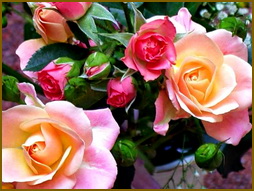Lily flower species. Common types of beautiful lilies: photos, varietal names, description
Lily is a beautiful perennial plant. It is common worldwide and very popular. Thanks to its beauty, this flower is capable of decorating garden plot. Divide these plants began in the 19th century. Before that, only the White Candidum knew in the world. Tiger species were distributed in Russia. There are many varieties of lilies that differ in the signs: time, flowering conditions, aroma, painting, shape, stem height. We will get acquainted with a variety of varieties of this flower but.
The image of lilies can be traced in ancient Egyptian and Roman traditions.
Main groups
There are more than 10,000 lilies of a unique variety. Due to the breeding of these plants, cultures are diverse in shades, growth conditions, aroma. In addition to the main groups, there are varieties based on their basis. All of them make up different classes. Main types:
- Species;
- Asian;
- Snow-white;
- Eastern;
- Orleans;
- Long shots;
- American;
- Interspecies.
Consider these lilies and a description of the varieties of each group.
Species hybrids
Species or walking hybrids are wilderly perennials. Different with small sizes. Have a strong smell. Beautiful, such plants have drawbacks, for example, complex care. In addition, walking groups do not tolerate frosts. Grow in one place.
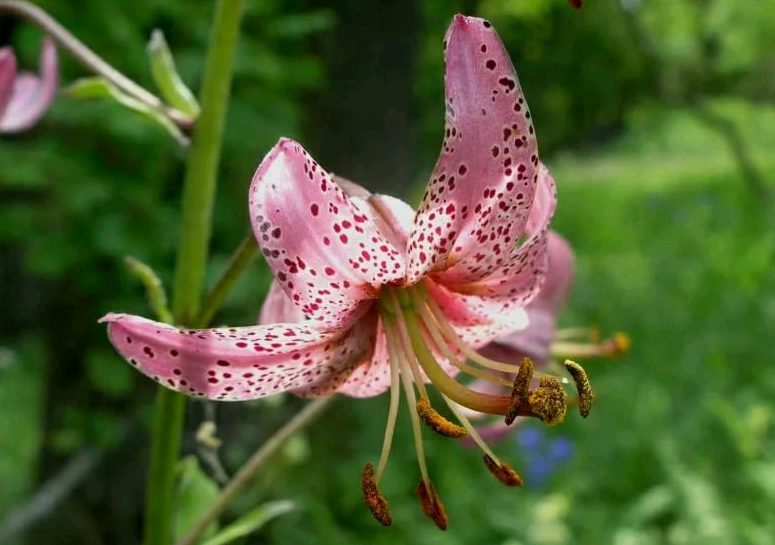
To varieties that are mastered in such conditions include the beautiful "March", "White", "Dauroskaya". "Tiger" - good viewHowever, it should not be grown with other plants. It has a virus that causes diseases in these colors.
Asian hybrids
In our country, widespread lilies themselves are excellent Asian species. There are about 5,000 items of these plants. They easily exist in the middle strip conditions, well tolerate strong frosts. Asian flowers are hardy, very spectacular. There are several major groups of these plants:
- "Fiesta";
- "Harlequin";
- "Pixie";
- "Brasmarks";
- "Tango".

All groups differ from each other. There are both small and huge high flowers in this form. So, the widespread "Brothers" plants have colored strokes. In this class, "Vangard", "Rostani" are popular. "Tango" is a bright variety of lilies, and "Pixie" is characterized by small sizes. Among the two-color groups are especially common, "sorbet", and from the terry - "Fata Morgan".
Asian lilies must be transplanted once every two years.
Snow-white hybrids
Snow-white hybrids appeared from European varieties. Plants of this kind are beautiful, high, white or yellow, tubular. Have a pleasant smell. Snow-white species are very easily infected with various diseases, do not tolerate frosts. The most famous variety "Apollo" is growing at the beginning and middle of summer.
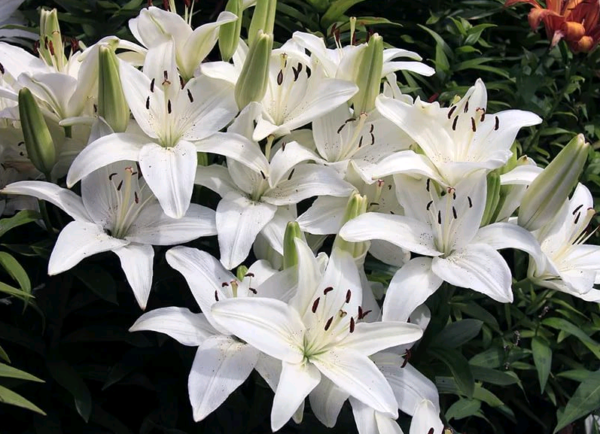
Eastern hybrids
Oriental lilies or oriental - beautiful flowers, popular for large inflorescences and thin flavors. They look good in bouquets. Care for plants is complicated. They need attention. In addition, hybrids are very susceptible various diseases. Flower in late summer, early autumn.
A huge variety of oriental species, various colors, heights, flavors, are obtained. Hybrids are divided into several groups depending on the inflorescence:
- Tubular flowers;
- Flat flowers;
- Chalmid flowers.
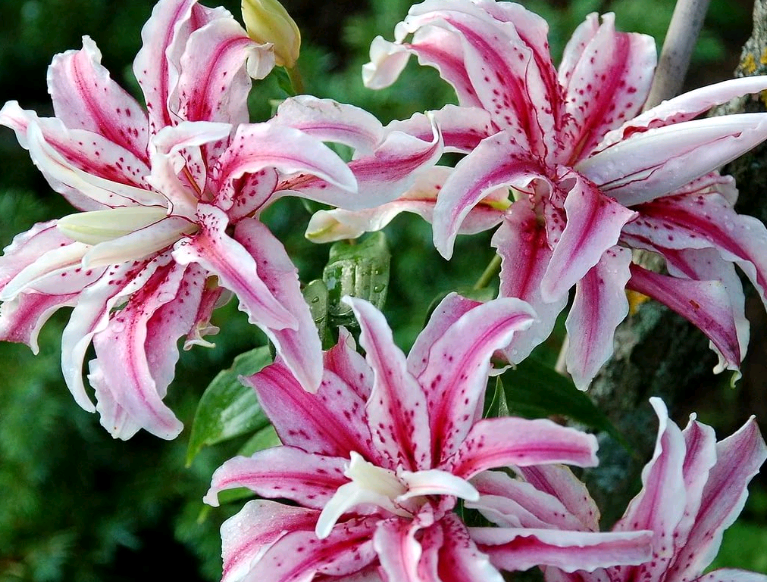
Very diverse oriental varieties of lily flowers. Thus, tubular species are very suitable for the conditions of the middle strip, and Chalmida is spectacular due to their form. Beautiful varieties of Chalmid hybrids include "Amalia", "Pink Chimka".
Orleans hybrids
Orleans or tubular lilies are whimping in care. However, the result of this is worth - Orleans hybrids have huge sizes, a strong pleasant smell, beautiful flowers.
There are more than 1000 varieties of tubular hybrids. They are divided into several groups in shape:
- Tubular;
- Invaded;
- Star.
Among Orleans hybrids themselves are common: "African Quin", "" and "Sarzhen". The greater advantage of this species is their resistance to disease.
Long-color hybrids
A group of long-bed lilies has a not a big variety of varieties. Growing in a greenhouse, but under certain conditions can grow in the ground. In Russia, they are almost not common. Have big buds, sweet fragrance. Famous varieties - Miyabi, Formozskaya. A good group is "Orange Pixie". They can be effectively used in the garden plot and in bouquets, especially in combination with other colors and plants.
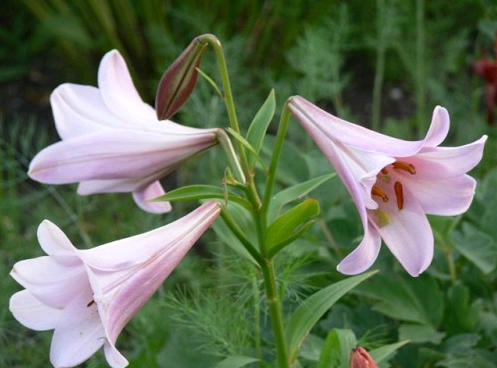
American hybrids
Small and very bright plants. Flower in the middle of summer. American lilies are distinguished by a bell-shaped shape, a height of about two meters, beautiful coloring in the speck on the flowers. American hybrids need care - they need watering, frost protection. Such varieties are popular as "Lake Tulaar", "Batterkap".
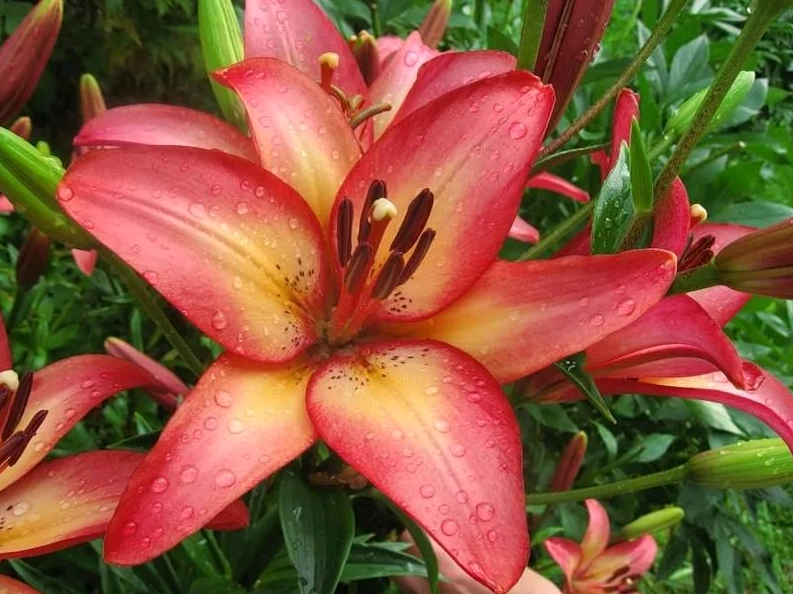
Intervidal Lilies hybrids
Intervidal varieties of lilies are the most modern types of plants. They are obtained by crossing different groups of these colors, combine the best qualities of each kind. Such plants are capable of achieving huge sizes.
There are several main types of intervidal varieties of lilies:
- La hybrids are obtained by crossing Asian and long-color groups (Longifloraums). Bloom in the middle lane. The breeders withdrew many types of white ("Iceberg"), pink ("Algarve") of yellow and other beautiful La species;
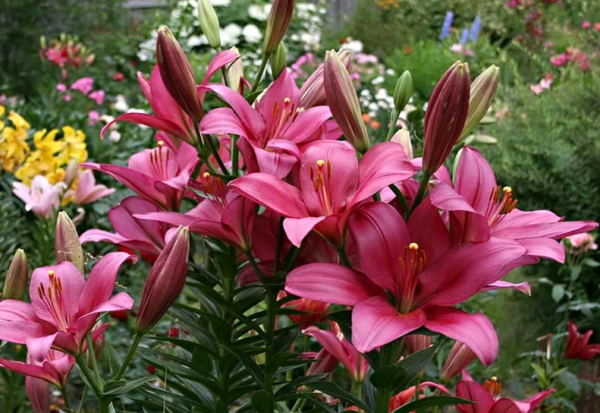
- OA-hybrids are species that were obtained from crossing Eastern and Asian cultures. Disease resistant plants. Culture, complex in breeding. The only popular variety of lilies is a dark red kaveri flower with yellow border;
- From-hybrids - flowers created by the crossing of eastern and tubular crops. Very high bright plants, resistant to diseases;
- Lo-hybrids are created by crossing oriental and long-bedding (Longifloraums) groups. Have very large flowers. Good grow in open soil. Attention is beautiful varieties "Triumfator", "Shoking";
- Rare species - AT hybrids obtained by crossing asian and tubular crops;
- The new group of hybrids Loo is distinguished by huge colors. Grow late summer, need protection from the cold.
In our country the best choice There will be the cultivation of Asian and walking groups. La hybrids and some species of oriental lilies grow well. Flowers also love to grow tiger species and rare.
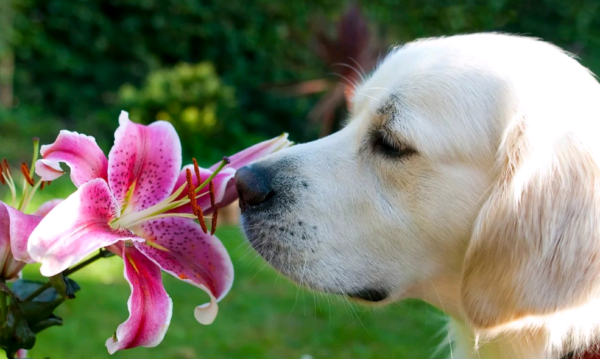
It is common that the fragrance of lily has healing qualities.
In stores you can find lilies of bush and pyramidal groups. There are no such types of plants, and the colors of this form are a consequence of diseases or external factors. There are varieties prone to this, for example, "Marlene" or "Aphrodite", but it is worth remembering that the flower of such species is not in each case there will become a bush.
It is best to plant lilies in the spring. The last duration of landing is the middle of autumn.

Outcome
Lilies - spectacular plants. They were popular for their beauty and fragrance. Thanks to breeders, exclusive varieties are displayed. In the article, the flower works discovered various varieties of lilies. A huge variety of lily varieties deserves attention. Grow different types of these beautiful plants on your site and achieve beautiful results.
Lily is one of the most popular cultures. The origin of the name of the kind is due to the White Lilia of Candidum: "Li-Lee" translated from the ancient Greek means "white-white". Therefore, the first idea of \u200b\u200blily is associated with a white flower. It was not by chance that the people are called the nymphyua: water lily for the form and color, although it belongs to another family.
Snow-white is one of the most ancient lilies that came to us from the depths of the centuries and has become a symbol of beauty, purity, indisputability and spirituality. Her images are found in the ancient Greek burials, they can be seen on icons, picturesque canvases. In Europe, she was named Madonna Lili. Before the appearance of the first hybrid lilies, natural species were grown in some countries. In Japan, for example, the breeding of local exotic lilies is excellent, or specialized, and golden, or auratum, has long been commercial. In the subtropical climate they were grown for sale by one of the thermal-loving lilies - long-color, or Longifloum (L.Longiflorum).
Starting from the 30-40s. The XX century in the gardens widely spread the royal lily, or regal (L.Regale), found in 1903 on Tibet Botany E.Vilson and the beginning of the new popular group of tubular hybrids. White painting of large tubular flowers and strong fragrance made it very popular.
In Russia, the DiKarak (L.Tigrmum), Dauric (L.Dauricum), Kudadvatoy (L.MartAgon), has long been grown in Russia. Moves out of nature closer to the houses, they pleased the Russians with their brightness and unpretentiousness. The first "cultural" Russian Lilia - Phials - was derived by I.V. Michurin through remote hybridization.
America also gave a rich material for breeding, hence the leopard lilies (L.Pardallinum) came, Canadian: (L. Sapas1epze), Michiganskaya (L.Michiganense) and others - 32 species.
And all the nerds are currently around 105 natural species.
Amazing, exotic beauty conquer the varieties obtained with the participation of lilies of beautiful, golden, long-decker, etc., but because of southern origin, they are poorly adapted to the climate of more northern regions, where a person is forced to create artificial conditions.
Warranty species of Eastern Esibirsk origin are short-lived and difficult to multiply, and therefore are not suitable for industrial cultivation. But they are a valuable source material for creating varieties resistant in local conditions.
Especially great success in breeding lilies were achieved in the last 30-40 years. Many varieties are obtained in Holland, USA and Canada, Japan, Australia, Russia, Latvia, Germany, Poland and the Czech Republic. There are more than 6,000 hybrid varieties of lilies derived from crossing various types.
In 1962, the American Lilievode Yang de Count systematized the varieties and hybrids of lilies, grouped them by origin. This classification in 1964 was approved as an international. It is very useful, especially beginners, since the most important features (soil requirements, frost resistance, drought sensitivity or excess of moisture, disease resistance) are the same in most representatives of each section.
Asian (Asiatic)
Flower shape is usually invasive or chalmid, there are several varieties with terry flowers. Coloring white, pink, cream, yellow, orange, two and three-color, red and dark burgundy, almost black. The disadvantage is the absence of fragrance. Unpretentious, winter-hardy, weakly susceptible to mushroom diseases and do not suffer from viral infections. It bloom well on sunny sites and in a half. Do not bring lime, prefer neutral or weakly acidic fertile soils. Easily breed vegetatively. Many varieties of this section form bulbies-kids in the sinuses of the leaves (boulevards). Such varieties are called bulbous.
Long-Deck (Longiflorum)
Flowers from tubular to almost star, usually white, very fragrant. Flower in July-August. Plants are not enough frost resistant, subject to viral diseases. Suitable for pastures and growing in pots.
Candidum (Candidum)
Tubular or funnel-shaped flowers, white or yellow painting, fragrant. The varieties of this group are susceptible to viral and mushroom diseases. We need reliable shelter for the winter, sunny location, well-fertilized, preferably lime, soil. The bulbs are planted in August, not blunting, since hybrids do not have malleuric roots. In September, the plants form sockets of wintering leaves, and next year - a colorless escape.
Eastern, Orientali (Oriental)
Flowers fragrant and odorless, tubular, cup-shaped, star, chalmid, very diverse in color. Flower in August-September.
For a long time were considered unsuitable for cultivation in the middle lane of Russia. But the modern range was replenished with varieties that successfully bloom and multiply in the context of the Moscow region. It is usually greatly amazed by mushroom diseases and viruses, but recently more and more new varieties resistant to infections appear.
Tubular and Orleans (Trumpet & Aurelian)
Flowers fragrant, tubular, less frequently Cupid or star, yellow, pink, orange. The outer side of the perianth is often darker inner.
Flower in July-August. Frost-resistant, prefer good garden land with the addition of leaf humus. Do not endure acidic soils. Not susceptible to viral diseases and sufficiently resistant to fungal infections. We need solar location and well-drained soil. The flower of tubular lilies is formed outside the bulbs - it is laid during the growing season on the color-point stem. Therefore, in the case of late frosts, there is a lack of flowering or the appearance of defective, ugly flowers.
American (American)
Flowers are usually chalmid, two-color, with a wine-red crap on a light background. The aroma is weak. Flower in July. Rare in culture, but well suited for the middle strip of Russia. Prefer sunny plots. We need abundant irrigation and weakness soils. Rarely form subsidiaries, vegetatively better breeding with bulbous scales.
Martagon
Flowers Chamidoid, diverse color, with dark stains on the inside of the shares of the perianth. Fragrance flowers weak. The most frost-resistant among lilies, durable plants are not subject to viral diseases, almost do not suffer from gray rot and are rarely affected by fusariasis. Long grow in one place, the transplant is carried out badly. Prefer the half. We need regular watering, to the soil is undemanding. Slowly grow, the daughter of the bulbs rarely form, so they are breeding in mostly bulbous scales.
Intersection hybrids
Plants obtained from crossing varieties from different sections among themselves are of great interest. They are called intersection hybrids.
Often, breeders are able to combine the advantages of different sections thus, eliminating some disadvantages.
Several groups have already been received:
. AA (Aurelian X Asiatic). Bloom in July, as a rule, have a strong fragrance. Frost resistant, not susceptible to gray rot and fusariasis.
. LA (Longiflorum X Asiatics). The most numerous group. Resistant to mushroom diseases and winter-hardy. From Asian lilies inherited a variety of coloring, but they have larger and beautiful flowers, pleasant aroma. We grow well on open or slightly shaded areas with neutral or weakness soil reaction. For the winter landing of this group of lilies, it is advisable to cover with leaves or peat.
. Lo (Longiflorum X Oriental) Flowers of short-cutting or funnel-shaped, white, white-pink or dense-pink color, with a pleasant aroma.
. LP (Trumpet X Longiflorum). It is well winter in the middle lane of Russia, sustainable diseases. Possess beautiful multi-scale inflorescences.
. OA (Oriental X Asiatic). Pretty unpretentious, life-in-law plants. Bloom in July.
. From (OR), or Orienpetes (Oriental X Trumpet) - hybrids. Plants with very large beautiful fragrant flowers, remind eastern, but less capricious. Flower from mid-July.
For Russian conditions, the most "light" are Asian hybrids. They are the most winter-hard and unpretentious, because they originate most of the Siberian species - the Lilies of Tiger, Daurosky and others. It is always easier to grow those varieties that are created on the basis of "local" species. The more the habitat conditions of the original species from local soil-climatic conditions, the more difficult for them in culture.
But, as a rule, more tender, at the same time more beautiful. But so I want to put them on your site! To do this, you need to know their requirements for soil and temperature conditions. If it is quite simple to prepare the soil, then create temperature conditions, and for Eastern hybrids there are also increased air humidity, much more difficult. Therefore, the oriental is better managed in greenhouses or at least under film shelter, it is more difficult - in the open soil. But with a great desire and patience, you can succeed.
Lilies are famous for their manifold. Appearance, Coloring, aroma, plant height and loss of inflorescences - all this is unique for each variety.
However, he caresses its garden lily collection, you need to pay special attention to the endurance of the variety.
After all, each view has the most persistent representatives - they should be preferred.
In this article, you will learn about what lilies come, and also familiarize yourself with the photo and name of the room lily.
In contact with
Types (varieties)
Consider Read more Description of varieties of lilies with photos and names:
- Spentive lilies are called wild grades that were derived by nature itself without the participation of a person. That is why flowers are quite difficult to grow them on their garden sites. This is why only an experienced specialist, who pre-examines the nature of the growth of the species lily "on the will" and creates similar conditions on its household site.
At the moment, about a hundred species of wild lilies are known. Only 16 of them grow in Russia. Among them there are more enduring winter-hardy species, there are also thermal-loving representatives of wilderness.
We will tell you more about winter-hardy varieties with their description and photo:
- - Its drooping, 8-centimeters in the diameter of flowers in shape resemble a chalm. Petals are painted with yellow or orange, decorated with salad stripes. High, up to 2 meters, the plant collects up to two dozen flowers in inflorescences and dissolves them in August.
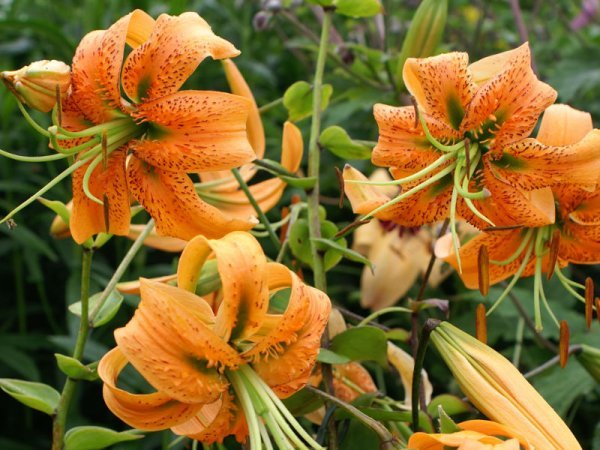
- It is similar to Lily Henry on a Chalmid form, but her petals have a pink-lilac shade and are darkened with dark clips. The plant grows up to 1.5 meters, blooms closer towards the end of June, the blossom of up to 30 flowers in inflorescence.
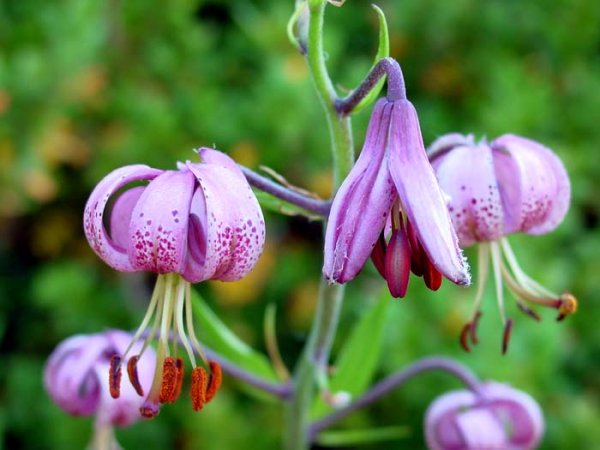
- Dauria Lily Has aimed up flower-bowls reaching 14 cm in diameter. Their color is red-orange, spotted. Inflorescences of 7 "CHASH" disgrace in mid-June. The plant itself by the end of summer reaches 120 cm.
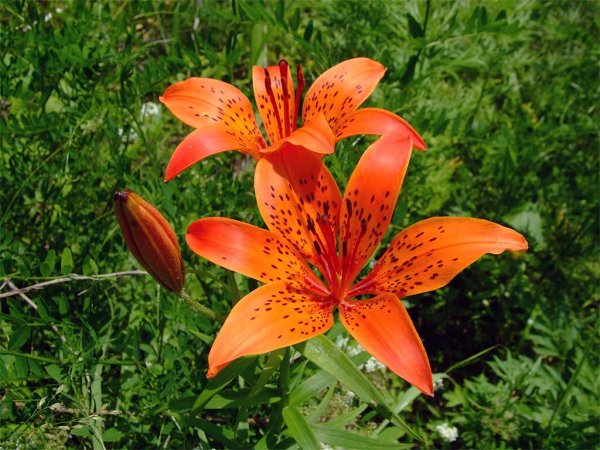
- Different with disrupting colors with slightly bent red-orange cracked petals. The diameter of colors reaches 10 cm, they are collected in inflorescences up to 15 pieces. You can admire them in the second half of summer. The height of the plant, as a rule, does not exceed 120 cm.

Heat-loving varieties are not inferior to their brethren on beauty. But all of them simply need a good shelter from cold weather, so often grown in tanks.
- Leopardit pleases its owners with original punching flowers in the form of Chalms. Spotted petals are partially yellow, partially red. The inflorescence consists of a dozen flowers that bloom with the onset of July. The height of the stem can reach from 90 to 150 cm.
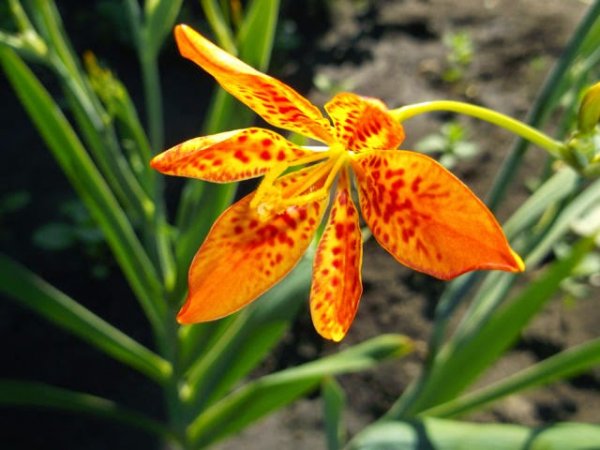
- Lily beautiful - These are large, fragrant flowers with a diameter of up to 15 cm and with wrapped petals. They can be white, pink or crimson. The edges of them are wavy, bloomed with dark raspberry spots. The stem grows up to 120 cm, the inflorescence collects to 15 flowers. Beautiful is beautiful in the very late summer or even with the arrival of autumn.
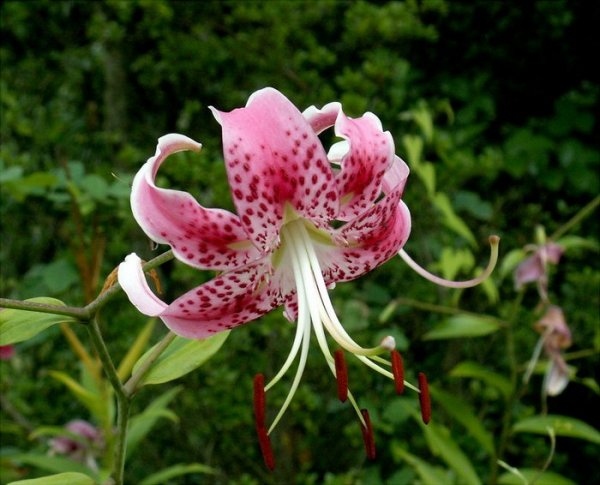
- Goldendiffers in large white 30-centimeter flowers-bowls. They are marked with a yellow stripe in the middle and brown specks, have a subtle aroma. The height of this variety is also impressive - up to 150 cm. Flowering time: August or early September.
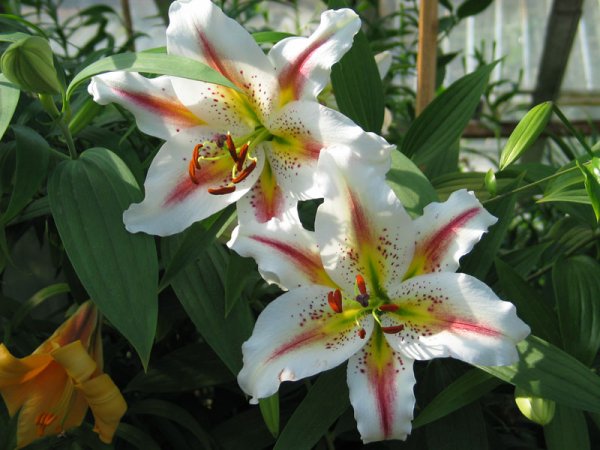
- This is a thermal-loving variety of species, wild lilies. White or snow-white (it is - Lilia Madonna) has dire directed by funnels with a diameter of 7 cm. The core is painted with a pale yellow color. In inflorescence, it is usually 20 flowers, they bloom in July and differ in a very strong aroma. The ordinary height of the plant is 1-1.2 meters. The view has a terry variety.
IMPORTANT! Flowers characterize this variety as very gentle, unstable to diseases, pests and cold, so most often the fragile snow-white lily is grown in containers.
- Spentive lilies are called wild grades that were derived by nature itself without the participation of a person. That is why flowers are quite difficult to grow them on their garden sites. This is why only an experienced specialist, who pre-examines the nature of the growth of the species lily "on the will" and creates similar conditions on its household site.

- Asian hybrids are most common in garden flower beds. They are considered the most persistent and unpretentious. The following varieties are distinguished by the greatest endurance:
- Lolllipop. - Spectacular two-color hybrid. The base of petals is white, tips - raspberry. Flowers are large enough, up to 15 cm in diameter, but no more than 5 pieces are collected in inflorescences. Lily itself is not very high: it does not grow above 80 cm. Blooms in June.
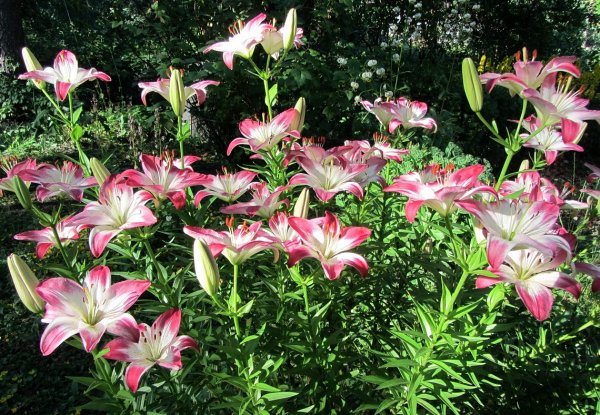
- Cola - owner of luxury wine-red flowers. Their diameter reaches 15 cm, which bloom on the stem 110 cm high.
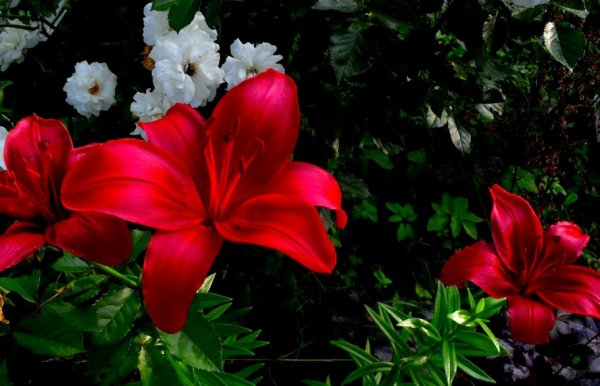
- Tinos - Contrast grade with tricolor petals: the main part is white, but at the base, they seem to be lit with bright red-yellow fire. Lily height reaches 1 meter, flowers at the very beginning of summer.
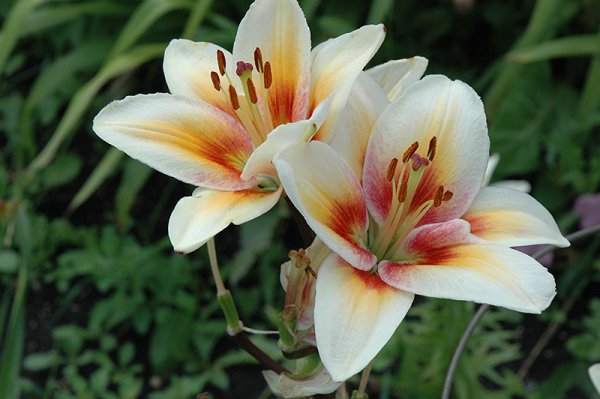
- Golden Stone. - grade with bright, lemon-yellow petals, dedicated frequent cherry-red spots. The diameter of flowers is about - 20 cm. Height ranges from 80 to 110 cm. You can admire bloom with the onset of June days.
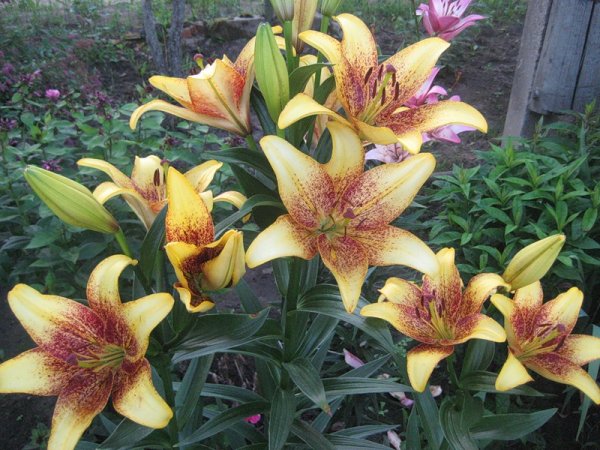
- These hybrids can boast of resistance to the Russian climate. Eastern hybrids are sparkled inflorescences-brushes. Large fragrant flowers are directed to the sideline or turn down down. The form is most often a star, in diameter can reach 25 cm and is distinguished by the wavy form of external petals.
- tubular(for example, Little Fairiz or Weisra);
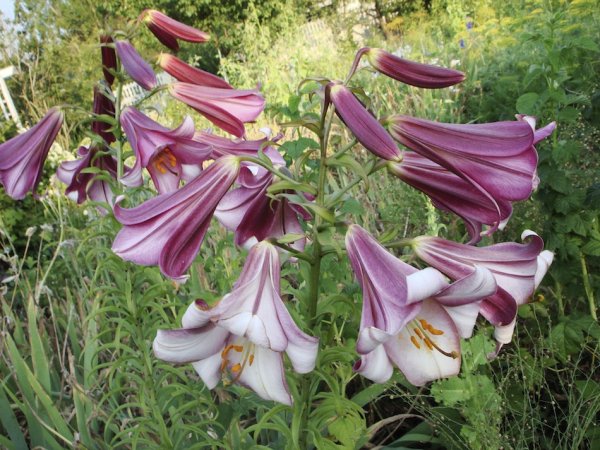
- chapheloids (Africa, Duska, Lavender Lady, Rad Band and others);

- widespread (Gillion Wallace, Impriel Gold, Aurora and others);
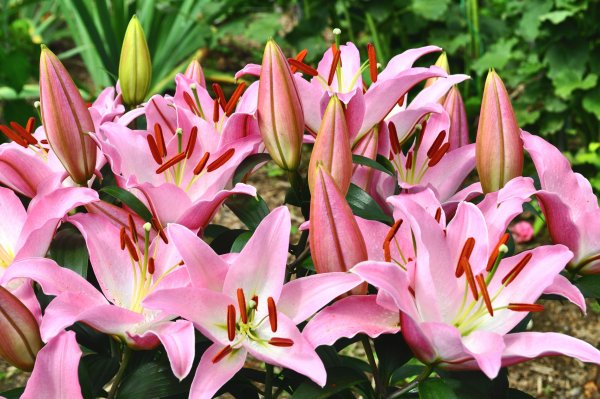
- chalmidoid or flowers with bent back petals (for example, Allegro, IVENING, ENTERPRYZ and OTHER).

Petal coloring covers all shades of pink, can be white. Some varieties have a bright golden strip in the center of the petals.
- She is a waterway or nymphya. A variety of lilies that grows in water - In garden plots it is grown in decorative water bodies. Round wide leaves float on her stroits, and the flowers are located on very long stems that endure them on the surface. The flowers prefer to grow winter-hardy grades, they include the following representatives of water lilies:
- The water lily is fragrant. Prefers a depth of 40 to 80 cm. Flowers are painted with pink or white and have a bright aroma.
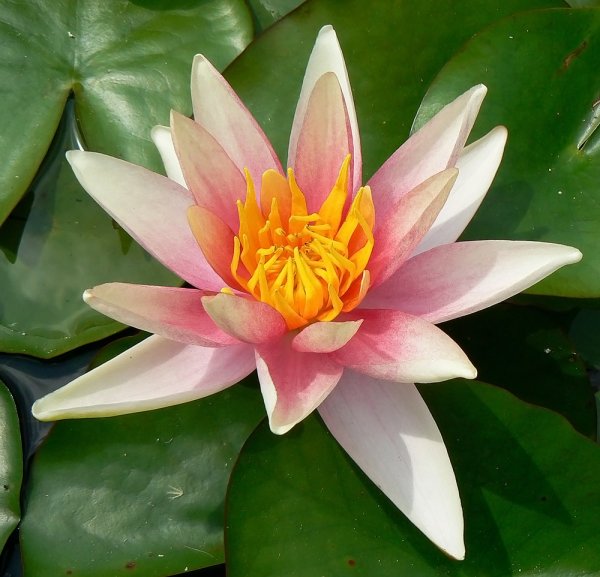
- White Walking Flashing with flowers with a diameter of up to 15 cm. Despite the name, varieties can have flowers of a creamy, pink or even red shade. This variety is able to grow at a depth of half a meter to 2.5 meters.
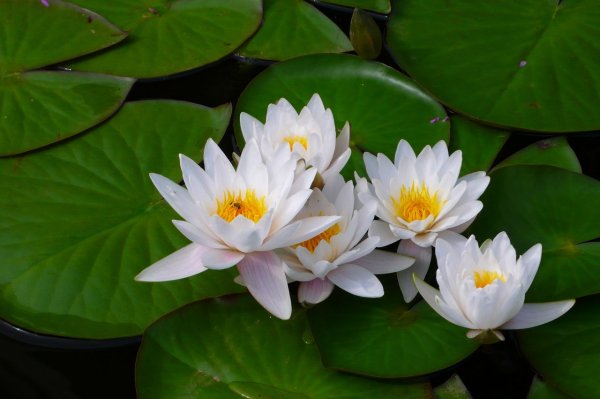
IMPORTANT!Snow white water lily - another variety. It is characterized by the longest blossom - throughout the summer. Flowers are distinguished by a snowy white and diameter up to 10 cm.
- Four-granular pita It has small flowers up to 5 cm in diameter. They are painted with white or pink color, sometimes the bottom of white petals - pink. The catching cup has a quadrangular shape, the corners are bent down.
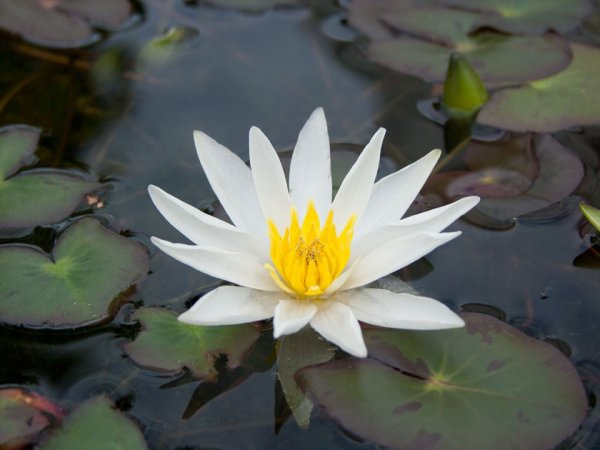
- Asian hybrids are most common in garden flower beds. They are considered the most persistent and unpretentious. The following varieties are distinguished by the greatest endurance:
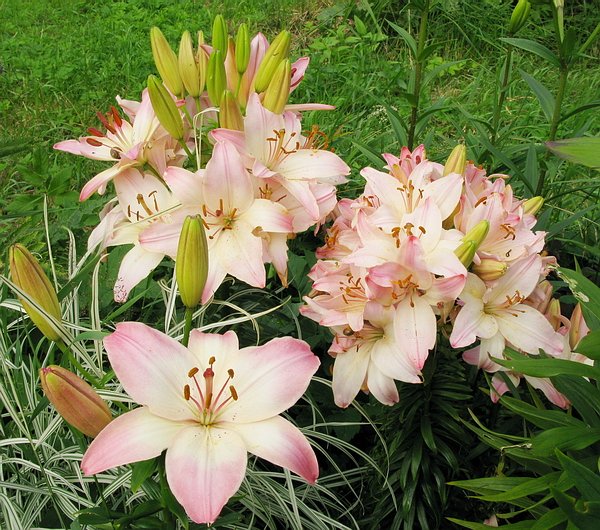
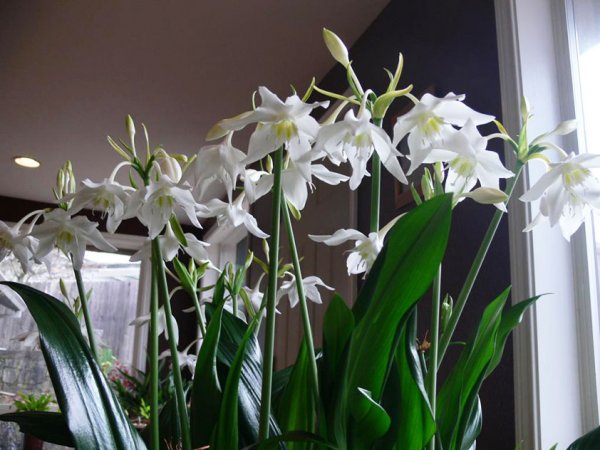
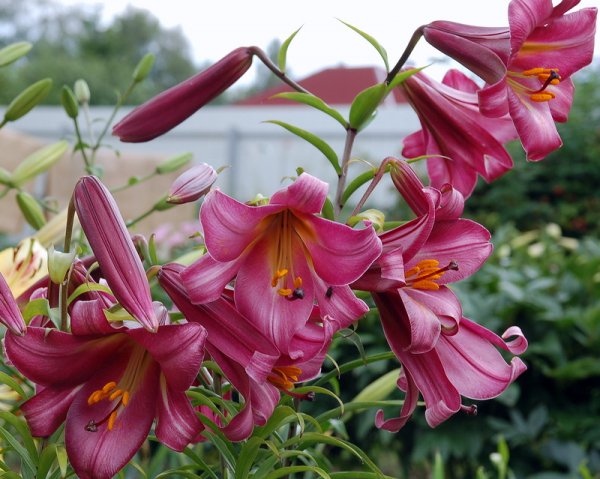
Each variety is beautiful, and the best way Decorate your garden plot - plant the flowerbeds with a variety of views. So you will achieve not only the rich palette of paints, but at a competent approach to provide continuous lily blossom for all summer.
Lilies are elegant bulbous flowers With a pleasant smell from the older times, they were attacked by the embodiment of the sophisticated beauty and purity. White lilies came to the colors of the goddess of Gera in Old Greece and Juno in Rome, and in the Christian religion, these white flowers have set up a emblem of indispensability and spirituality. Thanks to this worship, the snow-white plants earned the Prical title, one or another from the ancient Greek language "Li Li" means "white-white".
Rod Lily (Lilium) includes about 80 natural appearance of plants, from one or another the large number of hybrids and species of these colors is earned. Lilies enter the family of Lily and come relatives to flowers, ripples, onions.
Lilies Delivered long-term bulbous plants. The bulbs in them consist of juicy uncrowed scales, because it can be called loosely. On the scale of the bulbs in the diameter can be available from 1 to 30 centime., In the form attend shag-like or egg-shaped. Scales are fortified on the bottom - the lower amount of the bulbs, it breathes the point of growth and delivers the roots.
Koreshki In the lilies of 3 species: basal and pull-ups are formed on the bottom, and the surgical arises on the stem for one and the same season and the appeal dying together with the stem. When transplanting lilies, attempt not to break and do not cut the roots.
Trunk Lilies sincere in elevation visits from 15 to 250 Santim. Depending on the variety. The trunk is set to lily leaves, one or another sit on it, wrapped around the spirals, glowing the appearance of lilies, one or another bring the root rosette of the leaves, some leaves are assembled on the stem in a muve, the rest they pressed against the stalk. The trunk can be densely humble or with rare location Leaves. Some varieties in the sneakers of the leaves are formed by air bulbs on the stem.
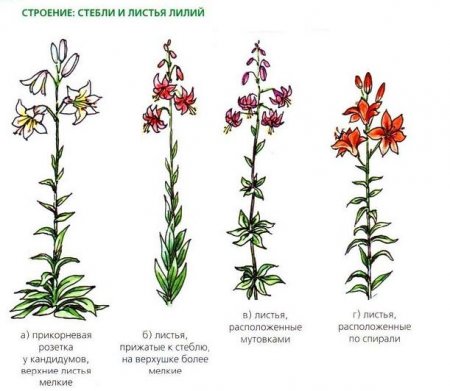
Inflorescence Lilies Forms a brush in the form of a cylinder, a cone or an umbrella. On average, the brush breathes 8-16 plants, the greatest number up to 30. Flowers in inflorescence are dissolved evenly, from the lower to the top. Each flower does not fade from 3 to 9 days, because the flowering lilies lasts from 2 weeks and most.
Lily flower It consists of 6 separate petals of placed in two lines, 6 stamens are highlighted in the center with large pesting anthers and a pestle, prompting a paint column - a snap, tightly clear painting, like anthers. The classic lily flower consists of 6 petals of them mostly only in terry species - Lilies Tiger, Kudryava, etc.
The shape of the plants of the lilies visit Chalmid, tubular, funnel-shaped, bell, invading, star, flat.

A wide palette of painting colors of the species of lily affects imagination: from white to la operal, yellowish, apricot, orange to clear red, gloomy violet, with specks or without, single-color or two-color with overflow, smears, spots or cut, not only blue lilies.
Flower scope Lilies depends tightly on its shape. Spreading chalmid lilies in the diameter achieved 5-10 Santim. And look like juvenile Chinese lanterns. High funnel-shaped flowers in the diameter do not exceed 4 Santim., And in length they achieve 15 centime .. Flat opened lily flowers can reach 25 Santim phones.
Lilies Extremely gloriously look in bouquets And perfectly mixed with other colors. They cut them off, sometimes in the inflorescence will open one and alikeones - two flower, other buds will evenly flaw and the bouquet will retain a decorative appearance of 7-10 days. Most of the lilies have a gentle pleasant smell, in some appearance it is extremely powerful and suffocating, therefore, bouquets with ecic colors do not have to position in the bedroom or not ventilated rooms.
Plot blossoms are formed by the fruits of lilies - high boxes with flat grains, they ripen by October, November. Traditionally, the blossoms of blooms are clouded, so that the plant has not given the set on the formation of the grain.
Thanks to the unrelent reputation, these long-term garden flowers are continuously updated with new varieties, at the moment there are more than 10 thousand them. By international Lili Classification Broken for 9 groups: 1 - Asian, 2 - curly, 3 - white, 4 - South American, 5 - long-color, 6 - tubular, 7 - oriental (oriental), 8 - interspecific modifications, 9 - natural appearance and varieties.
When buying, preferring a Lily variety, pay interest on their marking: The main Roman figure means a lily group; Proper beech the position of the flower ("A" - the flower is focused, "B" - to the country, "C" - down); After the fraction, the proper beech is the form of a flower ("A" - tubular, "b" - invasive, "C" - flat, "D" - Chamidoid).

In the Russian Federation, tightly grown lilies fromasian Group. This group is more numerous, includes about 5 thousand species, the most heterogeneous in color and form of plants. Asian lily varieties are visited by dwarf, 30 - 40 messengers., Most of the averages, elevation of 60-120 Santim., And giants up to 150 Santim. and higher. Flowers of Asian lilies in general do not fragrant. The mass spread of these lilies was their properties: unpretentiousness, winter hardiness, free and fast reproduction, comparative resistance to diseases.

2nd group of lilies - crispy modifications Plants have a distinctive appearance. The inflorescence recalls the candelabr with drooping small flowers up to 5 centime. In the diameter, the flowers of the Chalmid shape. In the inflorescence, the number of plants can reach 30. The plant's leaving is 1-1.5 m. The lilies of this group are grown in the shady corners of the garden, they are unpretentious, frost-resistant, but slowly rooted, planted bulb will bloom only after 1-2 years. These lilies are fruitful, the daughters of the bulbs are practically not formed. The group has the most 200 species, but they did not earn mass distribution.
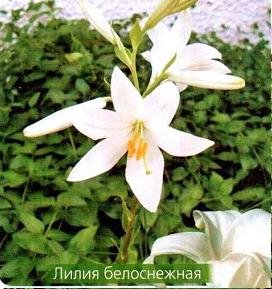
White group Lily includes about 30 species. These lilies have a snow-white or pale yellowish color and good fragrant. White lilies are grown only on sunny squares, they are fighting, not winter-hardy and are free to affect diseases.

South American hybrid lilies Not earned a huge celebrity, wanting these flowers extremely original and gods. The group consists of 140 species, most of the colors are clearly painted, two-color with a large grip. These plants are picky, badly carry out a transplant, because of the bulbs should be landed at the unchanging area. These lilies are the highest, good grow and bloom in half.

Long-color modifications Eliminated with an elused form of a flower with a direction to the country or down. To the upset of the variety of this group is not winter-hardy, they are denser than greenhouse culture. Flowers of the lilies of this group have a powerful smell.

Varieties of lilies from the grouptubular hybrids Also, the tiny are famous for us, if possible, as they are seriously fruit and not quite winter-hardy, call asylum for the winter. These plants can be attributed to the wayward, good grow only in the soil with a slightly alkaline or neutral reaction.
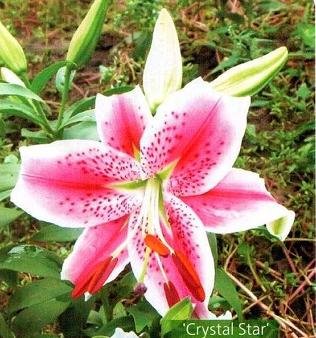
Lilies group of Eastern hybrids You can call an exotically beautiful, the flowers are highlighted in a rather large scale in the diameter from 15 to 25 Santim. And beautiful coloring. This 2th large group of lilies consists of 1300 species. Oriental lily is recovered to heat, prefer a sunny plot with shading in the heat. Happily grows only on a fluent loose light with a weakly acidic reaction. Tightly affected by diseases and die on the griming clay light.
Intervidal modifications They earn more and more distribution, because they are derived to obtain certain properties of the plant pair of groups, the most famous: la-modifications, from-modification, lo-modifications, OA-modifications.
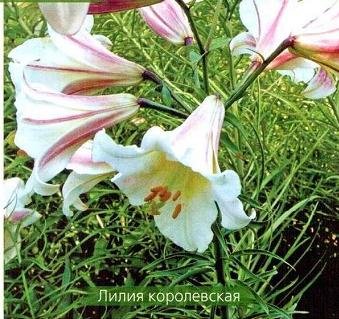
In the final group includednatural appearance lilies. They play a major role in obtaining the latest species, highlight some of them: White Lilia (L. Candidum), Lilia Tsarist (L. Regale), Lily Lanceatte or Tiger, Kudrya L. Martagon (L. Martagon), Lilia Henry (L. Genryi) , Lily beautiful (L. Speciosum), Dwarf Lily (L. Pumilum), etc.
Description and variety
Lilies - Perennial herbaceous bulbous plants from a family of Lily, with underground scaly bulbs. There are about 100 wild species common in East Asia, the mountains of India, North America, and more than 3 thousand varieties.

1. Bullbars in the sinus sheet.
2. Obsolete sheet.
3. Stem.
4. Babes are formed on the underground part of the stem.
5. Lukovitsa with bulbous scales.
6. Lukovichnaya Putitive roots.
7. Sadlukovy (St Bearing) Pressure roots
Plants from 20 cm to 1.5-2 m high with linear or lanceal leaves located alternately or mutton. Stem and leaves in some varieties and species are pubescent. The stalk color varies from bright green to brownish, sometimes even with a purple tint. BOOLBON SORDES AND TYPES OF LILIMS: In the sickness of their leaves are formed by the spikes (bulls) - special organs vegetative reproduction. Flowers are single or from 2 to 40 flowers are assembled at the top of the stem in the inflorescence of metelko, cysts, umbrella or palate. Flower with a simple perianth of 6 free fractions. Shares straight or bent back with nectarial iron at the base of each share.
A few forms of the Lily Flower Forms are distinguished: a funnel-shaped (or invaded), Chalmid, tubular, cup-shaped and bell-shaped.
A special decorative flower gives six strongly outstanding twins with elongated, bright colored anthers that are freely swinging on long thin bases. The size, shape and color of the flower vary, many flowers have a pleasant aroma.
The fruit is a box separated by partitions on 3 sockets.
The underground part of the plant consists of a bulb and a bunk or single-tier root system. Each bulb is a shortened perennial escape consisting of a stem part, conducted in a bulbous dona, and modified in juicy bulbous leaf scales. In the scales during the growing season, the supply of nutrients is postponed. Applying roots are departed from the Donets. The bulb is the organ of vegetative renewal and reproduction of the plant, the supply of nutrients. The root system is represented by the apparent roots - onion, growing from the dont of the bulbs, and the surgical (stem), forming the underground part of the stem. Plants S. different period Flowering, with flowers with a diameter of 2.5 to 30 cm any color and shades, except blue. Moreover, hybrid varieties have not only outstanding decorative qualities - they are worn and have increased resistance to diseases.
Garden classification of hybrid lilies is based on common biological features and origins. In accordance with the international classification, all hybrid lilies are grouped into 9 sections: (1) Asian hybrids; (2) Martag Hybrids; (3) Candidum hybrids; (4) American hybrids; (5) long-color hybrids; (6) tubular hybrids; (7) Eastern hybrids; (8) all other hybrids; (9) species lilies.
Asian hybrids make up the most numerous section of the lilies, it is represented the greatest number Modern varieties of lilies. This section combines varieties that differ in the form of a flower, coloring, height of the plant. Inside the section, depending on the direction of the flower relative to the stalk, three subsections are distinguished:
* varieties with referred to flowers,
* varieties with down flowers,
* varieties with flowers directed on the outside.

In the height of the plant, Asian hybrids are divided into low-spirited (up to 50 cm), the average (up to 100 cm) and tall (100-150 cm).
This section presents a Chalmid, tubular and Cartoid Flower Form. The largest flowers depending on the variety reach 12 cm in diameter.
Asian hybrids are distinguished by increased frost resistance when growing in open ground. The timing of flowering varieties of this group of hybrids is depending on the variety in the interval from the end of June at the beginning of August.
The Martag Hybrids are definitely not so extensive partition as Asian hybrids, but their varieties are no less decorative and loved by flowerfish. Flowers of varieties of this section are only a chalmid shape



and diverse color. A distinctive feature of flowers is their crawling, that is, the presence of small specks on the petals. Flowers with a diameter of up to 7-9 cm form powerful inflorescences on the tip of the bloody, the number of flowers can reach 20-25 pieces. Plant height 130-180 cm. Flowering of different varieties falls for the period from mid-June to the third decade of July. The Martag Hybrids do not differ in particular winter-hardiness when growing in the open ground and require shelter. Especially the late May frosts should be feared when the shelter is already removed and the bulbs can surf.
Hybrids Candidum are an even more small partition compared even with Martag hybrids. Flowers of varieties of this section are only a tubular shape with bent back tips of petals, which gives a flower a lightly elegant look. Flowers are large, up to 12 cm in diameter, form a compliance, in which it can take up to 8-10 flowers. The flowering of different varieties falls from mid-June to mid-July. The bulbs when landing should not be shuffled.
American hybrids refer to the rhizable type of lilies. The varieties of this section are characterized by high-spirits of plants that can reach 200 cm in height. Flowers predominantly chalmid shape, large, up to 10-12 cm in diameter, are collected in the pyramidal inflorescence. In inflorescence, flowers are located obliquely down and their number can reach 15-20 pieces. The flowering time falls in July, with the onset of cold weather, shelter is required. Lily small in variety.
Long-color hybrids- very gentle plants and in the conditions of our climate are practically not grown in the open soil. However, in the conditions of closed soil, the varieties of long-color hybrids give a cut of the highest quality and extraordinary decorativeness. Flowers of the narrowed and elongated shape are very elegant and look beautiful as a center in various flower arrangements. This section of lilies are also called the French sample of "Longiflo-Room" of hybrids. The varieties of this section are a little presented.
Tubular hybrids After Asian hybrids are the most extensive section in the number and variety of varieties presented. Depending on the shape of flowers and their location, four subsections are distinguished within the division of tubular hybrids:
* Flowers of the Chamid shape (twisting),
* Carticle Flowers,
* Tubular Flowers,
* Star-shaped flowers (flat) shape.
Flowers of tubular hybrid varieties are large elongated shapes, up to 20 cm long. Color painting of various varieties is very diverse, the color scheme covers the spectrum from bright red and raspberry colors to gentle pastel and white tones. Flowers of most varieties are distinguished by a strong pleasant aroma. Flowers of various shapes are assembled in inflorescence at the tip of the flower, in the inflorescence, it can be counted 10-15, and some varieties up to 20 flowers. Plants are usually tall, from 120 to 200 cm. The flowering of various varieties of tubular hybrids falls for the period from mid-July to mid-August. Plants are fairly hardy and frost-resistant, so most varieties can be grown in the open ground in the climatic conditions of the middle strip.

Eastern hybrids are characterized by an extraordinary saturation and purity of colorful and huge flowering size. Large flowers can reach 30 cm in diameter. Coloring flowers most often happens combined: red with white, pink with white, white with red stripes or stains. The shape of flowers in various varieties is diverse, flowers can be tubular, chalmid-noy, cup-shaped. The height of the plants is also widely varied, the varieties of oriental hybrids can be attributed to the low-speed (up to 50 cm), the average (up to 100-120 cm) and tall (120-200 cm).
Eastern hybrids are quite demanding to the landing site, so their cultivation and care will require certain efforts. The basic requirements of various varieties of Eastern hybrids are solar wind-protected place of growth and fertile soil with an acidic reaction from the middle-acid to acidic. For the winter period, the shelter of bulbs is required.
Sort
Asian red hybrids
Paprika, Grand Paradiso, Carmen, America, Monte Negro, Scarlet Sails, Fayer King, Diana, Red Umbrella, Red Lion, Inclinement, Stones, Sinnabar.
Asian yellow hybrids
Aelita, Golden Melody, Destini, Qitronella, Saularstarite, Sunny, Connecticut Quin, Golden Summer, Golden Bottom, Nova Sato, Walalow Sabmarin, Yellow Bird, Laksheri. Orange and salmon
Rotary, Orange, Connecticut King, Natalia, Elegant, Harmoni, Brendivine, Connecticut Yankees, Giselle, Volkhov. Pink
Veronica, Rosita, Vog, Cat D "Azur, Montreux, Svetlana. White
Sterling Star, Inks, Mont Blanc. Two-color
Rembrandt (pink with orange), Kansas (yellow with orange), Leonardo (white with pink).
Martag Hybrids
Mrs. Beckhaus (Yellow), Gay Laite (light pink), Marhanan (orange).
Hybrids Candidum
Ares (orange), Apollo (White), Preileld (Red).
American hybrids
Shuksan (bright yellow), Cherrywood (red).
Long-color hybrids
White Fox, Snow Queen.
Tubular hybrids orange and yellow
Rawtite, Spitrix, Harts Design, African Ku-
in, Race, Zanderbold, Golden Splandor, Limelaight
(with a greenish tint).
White
Atvassar, Richard Lyytty, Regal Gianthem, Green
Dragon, Black Dragon.
Lilac and pink
Vitsem, Pink Perfect, Dumbson.
Oriental hybrids red
Barbaresko, Starvezer, Bonfayer. White
Impress of Chinas and Imperial Silver (with red spots), Krimson Bjuti and Mona Lisa (with red stripes), Casablanca. Pink Pink Glory, Con Amore, Omega, Joneis End.
Other hybrids
Spirit (gentle-cream), Royal Delight (bright yellow), Royal Parade (Red), Royal Dream (White), Manyaker (Pink).
Species lilies
Lilia Regual (white with yellow yawn, purple outside, height 100-150 cm). Lily white (white, height 100-150 cm). Lily Tiger (orange-red, height 100-150 cm). Lilia Henry (yellow cracked, height up to 250 cm).
Terry lilies (new selection)
Sphinx, Aphrodite, Fata Morgan.
Breeding, conditions growing and care.
Typically, lilies are grown in one place without a transplant for 3-5 years. During this time, they form bulbs nests of different ages and magnitude. If lilies are sick in younger landings, they are definitely digging and transplanted to another place, without adhering to such a long periodicity of the digging. It should also be taken into account that the quick-acting lilies of Asian hybrids are transplanted more often, once every 3 years, and slow-speaking lilies in March and tubular hybrids less often.
The transplant time to a new place should coincide with the end of the growing season, when the bulbs of the lilies are fixed after flowering, which in the middle of Russia corresponds to the period from mid-September to the beginning of October. In everyday practical flower growing, methods of vegetative reproduction of lilies are most often used.
Reproduction of bulbs.
Due to the formation of one bulb of several renewal knelts after 3-4 years after the landing of the Asian and 5-6 years, the tubular in its place forms a whole nest of bulbs. Daughter bulbs with an independent root system are separated and planted as independent plants in mid-August. Terms These can be shifted at the end of the month or even on September. They are determined primarily by the state of the bulbs. After flowering, the lilies of the bulbs are very exhausted, lose weight, become friable, scales are thinned, they are tied. It must pass 1 - 1.5 months after flowering, so that the bulbs gained power - it became large, dense and elastic. All factors affect this process: heat, moisture, as well as meals. Under favorable conditions, in early August, the lilies of the June time of flowering (mainly Asian hybrids) are processed.
Stems of lilies need to be cropping, leaving the pencils, if by the time they are green, without signs of diseases. If the stems died out, which indicates the presence of mushroom diseases, then after squeezing the bulbs should be carefully unscrewed them.
The nests of the bulbs should be digging, without cutting the roots, after that, smooth the earth from them and inspect. The nests usually fall apart, but sometimes they have to share them with effort. It is made by hand, without the use of tools, after trimming the stems. Scales with rusty or brown spots need to be removed and destroyed. The roots must be trimmed by 15 cm, dead to cut at all. Clean bulbs with roots are treated by drying for 20-30 minutes in 0.1% solution of manganese. The separated bulbs are planted in the previously prepared land, which in dry weather it is necessary to pour on the day before.

Lily at the debts of the development of the plant in one place without a transplant is formed a nest of bulbs in which there can be several well-developed major bulbs. Such nests must be divided and planting the bulbs on one. It provides best food Each bulb gives her the opportunity to form a strong plant with good blossoms. To do this, the nest is digging, the stalks are cut and the hands are blocked by the nest, separating the bulbs, often well-fledged bulbs in the nest disintegrate themselves

1. After separation of the bulbs, the bulbs are processed and planted on a new place.
2. Major bulbs with well-developed fleshy external scales can be postponed to separate the scales for reproduction.
3. In the nest, there may be different on the size of the bulbs, they should be sorted, the depth of their landing and distance between plants depends on it.
Little lilies are planted to a depth of 10- 12 cm for large bulbs and 7-8 cm - for small, average-earth - respectively, 12-15 and 8-10 cm, tall - by 15-20 and 10-12 cm (depth is indicated before the bottom bulbs). The wells for landing should be done 10 cm deeper, as Lilies are transplanted with the roots that need to be carefully reinforced, swaying under the bottom of the bulb's pure river sand with a layer of 2-3 cm, and then fall asleep the ground. The minimum distances between the bulbs when landing for these groups are respectively equal: for low-speed lilies - 15-20 cm, for the average - 20-25 cm, for tall - 25-30 cm.
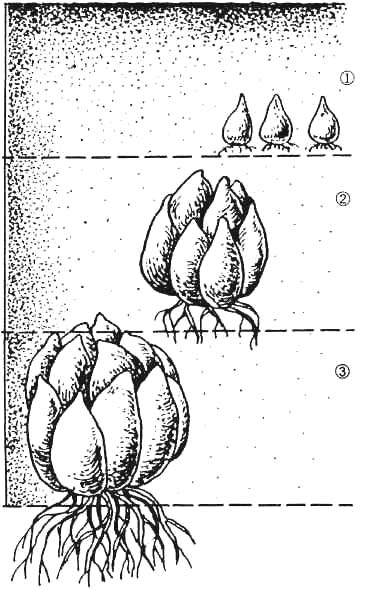
Depth landing lily bulbs
1. Babes, essential bulbs and lows developed on scales.
2. Middle-sized bulbs. 3. Large bulbs
Depth of planting bulbs lilies, cm
Reproduction kidsgenerated on the underground part of the stem. Children are separated from the parent plant during transplantation, or after the extension of the Earth from the stem. Branch and disembarking of babies to grow in August.

Reproduction by Bulboches. A number of so-called varieties of lilies have the ability to form small silent spikes in the sinus of the leaves - Bullbars. On one shoot, they can develop up to 150-100 pieces. The bulbousness of the varieties varies with the time of formation of bomb (before, during and after flowering), their number, size and color (from light green to dark brown). The increase in bulbiness and formation of larger boulevards contributes to the removal of buds and increased air humidity. Often, korekov, and sometimes 1-2 sheets, and sometimes 1-2 sheets are formed. At the end of the summer - the beginning of the autumn, the bulbs begin to be easily separated from the stem. At this point, they must be collected for subsequent cultivation and in order not to clog the planting. The collected bulbs must be treated with 0.1% solution of manganese, withstanding in solution for 20 minutes. Then the collected bubbes are planted for learning-vania into the grooves in a depth of 2-3 cm with a distance between the rows of 15-20 cm, between the bongs in the row - 5-6 cm.
For the winter landing, the boulevards are covered by a layer of 10-15 cm of wood leaf, sawdust or peat. Passionated bulbs can be planted into the ground for a permanent place after 1-2 years.
Reproduction of bulbous scales. This method, giving a large number of planting material (up to 150 and more from one bulb), is suitable for all types, hybrids and varieties of lilies. Based on the ability of scales separated from the bulb forming small bulbs. Scales for various types of lilies are different. The best term for a number of varieties from Asian hybrids and for the Lily of the Royal (Regal) - Spring, for tubular hybrids - flowering phase.
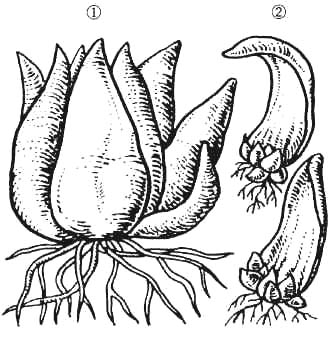
1. Cacheting is most often carried out simultaneously with the transplant of bulbs. The bulb should be digging and gently separate well-developed exterior large fleshy scales. From a large onion can be removed to 2/3 scales, it will continue to grow,
2. Scales removed should be rinsed, to be treated with a solution of manganese, dry and stored first in heat, then in a cool place. On the scales are formed tiny lows, which will gradually grow and develop the root system, in the spring they can be planted in the soil
With scales of lilies in the optimal dates for them, young bulbs are formed earlier and in large quantities. This way you can multiply lilies at any time of the year. Best result Get used to reproduction of external, largest and meaty scales. Scales must be white, healthy, without spots. To remove the scales, the bulbs are either digging (therefore, the scales are often carried out in August, combining it with a transfers of lilies), or they will unsubscribe land from them, but without breaking the growth of plants, in this way the squeaking is carried out in May. From the bulbs remove to 1/2 or up to 2/3 of all scales. The mother's bulb continues to grow and develop normally, the quality of its flowering is almost not reduced. The scales were washed and treated with 0.1% solution of manganese. After that, you need to dry them, put in a clean plastic bag, tie it up and place it in a dark place, where to keep about 1.5 months at room temperature (22-24 ° C). Then bags are preferably placed on a month in a cooler place, where the temperature does not exceed 17-18 ° C. Before landing, they need to be stored in the refrigerator at a temperature of 2-4 ° C. During this period, scales are formed on bulbs of different sizes, in best case - up to 1 cm in diameter. Depending on the time of year, they are planted in boxes, to greenhouses, in greenhouses or ridges open soil. The choice of a plot for growing lilies must be carried out carefully. All lilies require protection from a strong wind, but wet air stagnation, leading to the damage to the plants with gray rot, is very dangerous, so the site should be not only well protected from winds, but also enough to be ventilated.
Regardless of the spring or autumn lilies, the features of the whole complex of agrotechnical events are landed (choice of place, soil preparation, landing, care, warming for the winter) depend primarily from the affiliation of lilies to one or another: different groups of lilies impose different requirements for Growing conditions. Thus, Asian hybrids prefer weakness soils and light shading, although they grow well and in open sunny places. Tubular hybrids grow better on neutral and weakly alkaline soils, in open solar plots. Lilia Martagon and Eastern hybrids require accommodation in a half. Lilies need loose, water permeable nutrient soil, clean from rhizable weeds. Clay, waterproof and sandy lowland soils for lilies are not suitable. The plot on which landing lilies is planned should not be flooded with water, because from stagnation of water, the bulbs can easily bend and die. Since many lily belongs to forest plants, it is suitable for them with fertile soils with a large humus layer, released from under the deciduous forest.
Since lilies are planted for a long time (Asian hybrids for 3-4 years, tubular - for 6-8 years), the preparation of the soil plays an important role in their culture. Under the people (per 1 m2) to 10 kg of humoring, up to 20-50 g of bone flour, 15-20 g of urea, 30-50 g of a simple or 20-25 g of double superphosphate, 15-30 g of potassium sulphate. The Asian hybrids make a peat, for tubular soils lime, bringing lime under the preceding culture or spring. Soil treatment lead to a depth of 35-40 cm.
The depth of planting for lilies forming only bulbous roots should not exceed 2-3 cm, considering from the top of the bulbs; For forming shuttle (stem) roots - 3 heights of the bulbs. The landing depth is reduced for young bulbs, as well as on heavy soils.
Link landing
Lily bulbs can be planted in a basket that will save them from moles and mice-pools. To do this, dig a hole sufficient to accommodate the baskets in it, to bed a drainage layer with a thickness of at least 10 cm, pour into the basket with the soil and put into it the bulb, on the depth size provided by its size. After that, put the basket in the hole, fall asleep soil and compact it around the basket
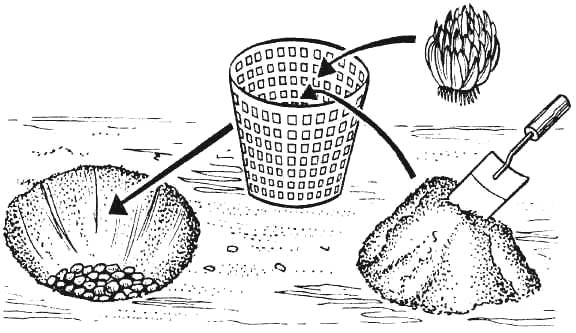
It is not enough winter-hardy and more powerful tubular hybrids to be planted to a depth of 15-20 cm. When transplanting cannot be allowed to dry the bulbs and their roots, this adversely affects the survival, overreving and further growth of plants. The bulbs are planted in a layer of sand (3-4 cm), full of holes on the bottom of the hole, which protects the dons of bulbs from the posting. After landing, the soil is abundantly watered and mulched.
Landing care ordinary: Weeding, watering, loosening and feeding. For the winter, plots with tubular hybrids and small bulbs are covered by a layer of 15-20 cm of a mulching material. In the spring, before the appearance of escapes, the plants are fed by ammonia nitrate (30-40 g / m2), and after the appearance of shoots - a complete mineral fertilizer in a dose of 40-60 g / m2; The same feeder is given during the period of bootonization and after 1 to 2 weeks after cutting.
Due to the fact that the lily lilyukic roots are located in the upper layer of the soil, its drying and overheating adversely affects the development of plants. To avoid the drying and overheating of the surgious roots, the soil is mulched with organic materials or a peat layer 3-4 cm. Water under root, since the moisturizing of the leaves contributes to the development of gray rot. For the formation of larger bulbs when growing on planting material, plants remove the resulting buds. Lily flowers are cut off early in the morning or late in the evening, and in cool, cloudy weather - at any time. For the normal development of the bulbs when cutting inflorescences on the plant leaves at least 1/3 of the length of the stem.
Diseases and pests.
Mushroom diseases are most common: gray rot (Botritis), fusarious rot on bulbs, less common, but viral diseases are most dangerous. The pests are most dangerous to the onion ticks, Lukova Burchal, and in the greenhouse - the trouble.
